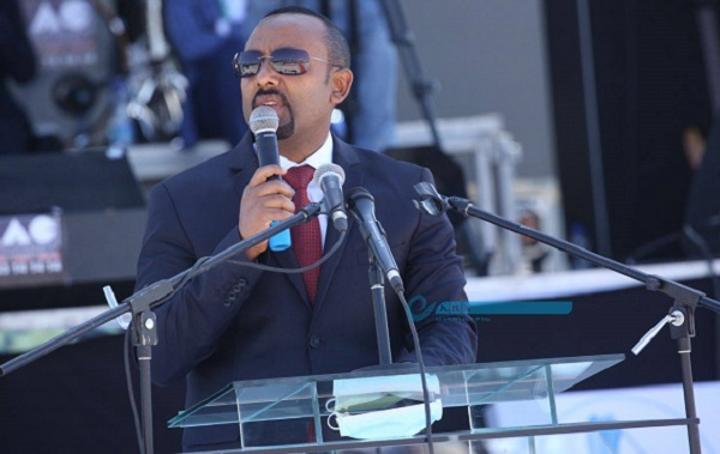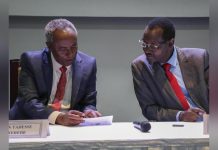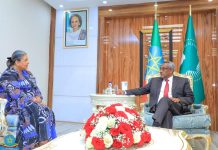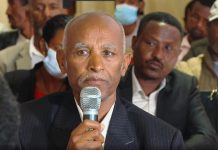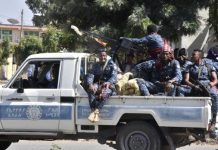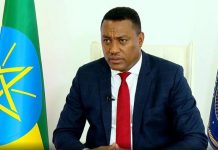Africa-Press-Ethiopia
On Nov. 4, 2020, the Tigray People’s Liberation Front (TPLF) attacked Ethiopia’s Northern Command headquarters. In response, the Ethiopian National Defense Force (EDNF) initiated a large-scale military operation throughout the northwestern province of Tigray. Ethiopian Prime Minister Abiy Ahmed characterized the campaign as a “law enforcement operation,” but such euphemisms obfuscate a frightening reality. The Tigray conflict constitutes an international civil war that has spawned a humanitarian crisis and risks destabilizing the broader region. More than 60,000 Ethiopians have fled to Sudan. At least 2 million people have been displaced internally. And 1.3 million people are in desperate need of aid. More troubling still, unsettling accounts of human rights violations and mass atrocities emerged soon after hostilities began. As human rights organizations assess the credibility of these claims and reconstruct events, a horrific picture has developed.
Although the worst allegations involve Eritrean forces, no party appears innocent. The EDNF, the Eritrean military, and Tigray and Amhara militias may all have violated international human rights law and the law of armed conflict. In Mai-Kadra, retreating Tigray militia allegedly murdered hundreds of ethnic Amharas. The Fano—an ethnic Amhara militia—may have carried out reprisal attacks on Tigray refugees. EDNF and Eritrean forces have shelled residential areas and killed scores of civilians, and survivors have shared grisly accounts of massacres and extrajudicial killings at the hands of Eritrean forces. To make matters worse, Doctors Without Borders recently documented widespread, intentional attacks on Tigray’s fragile health care infrastructure.
Such conduct not only violates the law of armed conflict but also impedes postconflict reconciliation, undermines regional stability and complicates U.S. national security objectives in the Horn of Africa. It is imperative that U.N. officials and independent observers gain full access to the region to investigate these allegations and mitigate the chance of further atrocities. This cannot occur without a full cessation of hostilities, and the U.S. must continue to pressure all parties to achieve that goal.
Conflict Overview
Tensions between the Ethiopian government and Tigray have simmered since popular protests brought Abiy to power in 2018. The TPLF—the party that governs the northwestern province of Tigray—governed Ethiopia for three decades after leading the insurgency against Mengistu Haile Mariam and the Marxist Derg. Mistrust between Abiy and the TPLF runs deep. According to the TPLF, Abiy, a member of Ethiopia’s largest ethnic group, formed the new, countrywide Prosperity Party in violation of Ethiopia’s federal constitution. Moreover, the TPLF claims that Abiy excluded Tigrayans from leadership roles and targeted TPLF leaders with unfounded corruption charges. Therefore, the party refused to join his ruling coalition in 2019. For his part, Abiy claimed that the TPLF bore responsibility for a grenade attack at one of his rallies and labeled them terrorists. Tensions reached a breaking point in spring 2020. Abiy postponed national elections due to the coronavirus pandemic, but the government’s constitutional mandate expired in early October. The TPLF disregarded the order to delay elections, and its leader, Debretsion Gebremichael, declared that “we will never back down for anyone who is intended to suppress our hard-won right to self-determination and self-rule.”
In September 2020, the TPLF organized a regional election in defiance of the federal government’s order. Abiy immediately dismissed the results of the unauthorized ballot and suspended the disbursement of federal funds to Tigray. Matters came to a head on Oct. 29, when TPLF leaders refused to accept the government’s regional appointees and pledged to block all EDNF movements in Tigray. On Nov. 4, Tigrayan forces attacked the EDNF Northern Command headquarters, claiming “pre-emptive self-defense.” Further conflict seemed certain.
Declaring a state of emergency, Abiy issued arrest warrants for 167 TPLF leaders, cut Tigray’s telecommunications and mobilized the EDNF for a “law enforcement operation.” The central government appears to have coordinated the operation with regional security forces from Amhara and the Eritrean military, and the U.S. government assesses that Eritrean forces launched artillery strikes to support EDNF operations. After quickly seizing key towns in Tigray, the EDNF encircled the regional capital of Mekelle on Nov. 22, and the government issued an ultimatum for TPLF leadership to surrender within 72 hours. When the deadline passed, the EDNF assault on Mekelle began. Meanwhile, Eritrean forces crossed into Ethiopian territory and assaulted TPLF strongholds along the border, while provincial security forces and ethnic militias from Amhara province supported EDNF operations in western Tigray. Prior to Abiy’s parliamentary address on March 23, few government officials would even acknowledge the presence of Eritrean forces, but it is widely reported that they remain deployed throughout northern Tigray. Similarly, Amhara officials have established a provisional government and effectively annexed a long-disputed portion of western Tigray.
Abiy claimed victory on Nov. 28 and told Parliament that no civilian lives were lost. But facts on the ground belie these claims. Indeed, following the government’s victory pronouncement, Tigray forces fired missiles at targets in the neighboring state of Amhara and across the border into Eritrea. In late December, the government shelled additional targets outside Mekelle, and TPLF forces continue to engage government troops and their partners throughout Tigray. The conflict appears far from over.
The conflict is evolving steadily into a low-level insurgency. With TPLF leadership ensconced in the mountains and strong popular support, the conflict could endure for some time. In October, the International Crisis Group assessed that the TPLF could field 250,000 well-trained militia. Moreover, as Emmanuelle Igunza, a BBC reporter for East Africa, reminded listeners on the Lawfare Podcast, the TPLF fought a successful insurgency against the Derg from Tigray’s highlands, and their forefathers waged a guerrilla war against Italy’s colonial forces in the same hills. In January, Debretsion seemed to channel this history, vowing “extended resistance” and calling on all Tigrayans to support the cause. Control Risk Group believes the government’s actions have engendered “a fertile recruitment ground for secessionist or otherwise anti-government ethnic militias.” The TPLF will not admit defeat, the government refuses to negotiate and alleged atrocities harden hearts on all sides. Peace does not appear imminent.
Humanitarian Crises and Regional Instability
The conflict has engendered an acute humanitarian crisis, and indiscriminate violence aggravates these challenges. The region’s crops already suffered from record-setting locust swarms in 2020, and fighting now impedes the delivery of food aid. If the conflict continues into June, it could disrupt the growing season and precipitate a full-blown famine. Similarly, estimates of internally displaced persons present staggering numbers. In January, a government official stated that Tigray has 2.2 million internally displaced persons, and 45,000 people from western Tigray relocated to the town of Shire alone. Fortunately, international agencies have gained access to some parts of Tigray in recent weeks, and aid has begun to flow to these areas. Nevertheless, the U.N. Office for the Coordination of Humanitarian Affairs (UNOCHA) recently assessed that nearly a million people remain in areas deemed inaccessible due to the “highly volatile and insecure” operational environment. The International Red Cross has warned about a lack of water, medical supplies, and other essentials, and UNOCHA has called the situation “dire.” Nor are the conflict’s effects confined to Tigray. Since November, more than 60,000 refugees have fled to overcrowded Sudanese camps. This influx taxes limited humanitarian resources, as the two largest camps are designed to support no more than 20,000 people.
Food security and refugee flows are not the only ways the Tigray conflict affects the broader region. For more than a decade, Ethiopia has served as a close U.S. military ally, and analysts consider it “the strategic linchpin of the volatile Horn of Africa.” But if the Tigray conflict transforms into a long-running insurgency, Ethiopia could become a source of instability for neighboring states. For instance, Ethiopia contributes 5,000 peacekeepers to South Sudan, provides 4,000 troops to the African Union’s mission in Somalia (AMISOM) and deploys another 15,000 troops to Somalia bilaterally. Vanda Felbab-Brown, co-director of Brookings’s Africa Security Initiative, believes that the presence of Ethiopian troops stiffens the resolve of Somali forces, noting that al-Shabab attacks increase whenever Ethiopian personnel withdraw from an area. The Tigray conflict could unravel AMISOM’s limited security gains. Ethiopia redeployed some of its forces from Somalia to Tigray, and the military confined more than 200 ethnic-Tigrayan troops deployed to Somalia due to security concerns. Felbab-Brown argues that such “purges weaken the morale, cohesion, and capacity of anti-Shabab forces,” and she fears that a weakened Ethiopian presence in Somalia will destabilize the country. A similar dynamic has occurred on the Sudanese-Ethiopian border, where Ethiopia redeployed forces from the contested al-Fashqa Triangle to Mekelle, and the Sudanese army destroyed EDNF outposts and displaced Amhara farmers in late December. Skirmishes have continued throughout the winter.
Alleged atrocities exacerbate these humanitarian crises and regional tensions. Parties may grow increasingly unwilling to negotiate, refugees may not feel safe to return home and the EDNF’s effectiveness as a multiethnic fighting force could deteriorate. Moreover, unlawful, indiscriminate violence threatens critical food stores and could precipitate a famine. It is therefore imperative that the international community broker a cessation of hostilities and fully investigate alleged atrocities.
Human Rights Violations, Mass Atrocities and Possible War Crimes
At the start of the conflict, Addis Ababa blocked all internet and telecommunications services in Tigray. Nevertheless, credible reports of indiscriminate shelling, extrajudicial killing, pillaging and sexual assaults slowly reached the outside world. Refugees shared harrowing stories of abuses committed by the EDNF and Amhara militias, while Abiy claimed that TPLF forces intentionally destroyed nonmilitary infrastructure and used civilian sites as “hideouts.” Four months after the conflict began, human rights organizations, international observers and investigative journalists have leveraged satellite imagery, eyewitness reports and documentary evidence to flesh out these claims.
Ethiopian National Defense Force
Despite Abiy’s “law enforcement” rhetoric, the operations in Tigray easily meet the legal threshold for armed conflict and trigger treaty obligations for Addis Ababa. Common Article 3 of the Geneva Convention establishes baseline protections for civilians in a noninternational armed conflict, and Additional Protocol I provides guidance for the selection of military targets and the safety of civilian populations. Proportionality, distinction, humanitarian restraint and military necessity are the analytic lodestars. Abiy has claimed that the EDNF took “all necessary precautionary measures … to ensure that civilians [were] not harmed … and to protect historical monuments, places of worship, public facilities, [and] infrastructure.” If true, these precautions would accord with the law of armed conflict; however, on-the-ground reports tell a different story.
In February, Human Rights Watch issued a detailed report documenting indiscriminate EDNF (and Eritrean) shelling of urban areas. Drawing on discussions with doctors, forensic experts and 37 eyewitnesses, the report describes artillery attacks on densely populated areas and corroborates the allegations with photographs, videos and satellite imagery. The report concludes that artillery fire struck homes, hospitals, schools, hotels and markets in Mekelle, Humera and Shire, killing 83 civilians and wounding 300. While Human Rights Watch notes that legitimate military targets, such as TPLF offices or training camps, were located near some impact sites, the overall damage suggests a dangerous lack of targeting discrimination. Moreover, the BBC reported that TPLF forces withdrew from Mekelle before the EDNF offensive began. If true, such shelling may also fail to meet the requisite threshold for military necessity.
Amnesty International has documented the results of indiscriminate shelling in Axum as well. After an initial wave of aircraft attacks, the EDNF and Eritrean forces initiated a joint artillery strike on Axum on Nov. 19. Witnesses described continuous shelling throughout the evening that struck residential buildings and decimated entire families.
Eritrean Forces
Addis Ababa only recently acknowledged Eritrea’s involvement in Tigray, but the international community has long recognized the deployment as fact. The U.S. State Department has received credible reports of looting, sexual violence, and assaults in Eritrean-controlled areas and called on Eritrea to redeploy its forces immediately. In an interview for International Crisis Group, Alex de Waal, one of the leading experts on the Horn of Africa, claims that Eritrean troops have ransacked food stores, intentionally ruined food supplies and killed livestock. If true, such actions would aggravate the region’s acute food insecurity and clearly violate the law of armed conflict. These crimes, however, pale in comparison to other allegations about Eritrean forces, to include indiscriminate targeting, forced transfers of refugees and civilian massacres.
Article 49 of Geneva Convention IV—to which Eritrea is a party—explicitly prohibits “individual or mass forcible transfers” of civilians in occupied territory unless required for their security or military necessity. Reports indicate that Eritrea may have violated this precept. Before the conflict, the U.N. Refugee Agency (UNRA) provided support for 96,000 Eritrean refugees in four camps across northern Tigray. UNRA withdrew at the start of the conflict, and the camps soon fell under Eritrean control. Witnesses have claimed that Eritrean soldiers arrested dozens of refugees and forcibly removed them from the camps. Imagery analysis lends some credence to these claims. DX Open Network, a British open-source investigations group, analyzed satellite imagery of the Hitsats and Shimelba refugee camps and concluded that both had been demolished. Prior to the conflict, the two camps had hosted 25,000 Eritrean refugees. The status of the refugees remains unknown.
Other investigations have shed light on alleged massacres committed by Eritrean troops. In a Feb. 26 report, Amnesty International provided extensive documentation about a horrific incident in the town of Axum. The report drew on interviews with 41 ethnic Tigrayans who survived the attack and fled to Sudan. According to the report, during the afternoon of Nov. 28, 2020, Eritrean soldiers randomly shot civilians in the streets of Axum, systematically searched houses, and executed men and boys. Witnesses claim that the soldiers operated vehicles with Eritrean license plates, wore Eritrean uniforms and spoke an Eritrean dialect of Tigrinya. The following day, Eritrean troops reportedly shot at any residents who tried to remove bodies from the streets. Amnesty International has identified more than 240 victims by name and estimates that several hundreds may have been killed. Analyzing satellite imagery, the group may have located signs of mass burial sites in the town.
CNN also investigated an alleged massacre at a remote monastery in the village of Dengelat on Nov. 30. They interviewed 12 eyewitnesses, spoke to the relatives of 20 survivors and collected photographic evidence. According to these accounts, Eritrean troops attacked the church while hundreds celebrated an Orthodox festival. As many as 50 people may have died as troops fired on the church, dragged people from their homes and pursued fleeing residents on mountain paths. Witnesses claim that the violence continued for three days and that several children lost their lives.
Finally, analysis indicates that Eritrean forces conducted indiscriminate shelling of dense commercial and residential areas in Tigray, often in conjunction with EDNF operations. For instance, in the town of Humera, a day-long barrage struck a wide array of civilian structures and killed scores of residents. Human Rights Watch employed satellite imagery to identify potential firing positions outside of Humera. The locations, situated on a hill 2.2 miles from Humera, lie just inside Eritrean territory. Both sites bear the telltale blast marks of artillery fire, the positions lie within range of impact sites, and imagery reveals vehicle tracks leading to the locations during the assault. Furthermore, the trajectories corroborate eyewitness accounts from Humera. Eritrea may not bear sole responsibility for civilian casualties, but the evidence strongly suggests its direct involvement.
Regional Forces and Ethnic Militias
State parties are not the only perpetrators of such violence. On Nov. 9, as many as 500 civilians—mostly ethnic Amhara seasonal workers—were killed in the western Tigray town of Mai-Kadra. An Amnesty International report cites several eyewitnesses who claim that TPLF personnel carried out the attacks. Residents report that the assailants struck down unarmed civilians with machetes and knives. When the EDNF and Amhara militias entered the town on Nov. 10, corpses lay on streets throughout the town’s commercial center. Several photographs support these claims, and an independent pathologist commissioned by Amnesty International confirmed that sharp objects caused the wounds. The TPLF is likely responsible, but they are not alone in perpetuating ethnic violence.
The New York Times obtained a U.S. government report that outlines Amhara militias’ efforts to “deliberately and efficiently render[] Western Tigray ethnically homogenous through the organized use of force and intimidation.” The report goes on to describe “whole villages [that] were severely damaged or completely erased.” Human Rights Watch debriefed refugees from western Tigray, and their stories add detail to this narrative. They described the heavy shelling of Humera, a town near the border with Eritrea and Sudan, and claimed that Amhara’s regional security force and informal “Fano” militia entered the towns after the initial EDNF assault. Witnesses report that after the initial fighting, Amhara security forces and Fano militia detained residents, looted hospitals and homes, and stole livestock and food stores. According to Human Rights Watch, many refugees now fear returning home.
Attacks on Health Care Infrastructure
Countless treaties and centuries of customary international law prohibit belligerents from attacking medical personnel and hospitals. According to a new Doctors Without Borders report, the parties have repeatedly violated this norm in Tigray. Oliver Behn, the general director of Doctors Without Borders, stated that Tigray’s health care infrastructure has experienced “a deliberate and widespread attack.” The Doctors Without Borders investigators visited 106 medical facilities between mid-December 2020 and early March 2021 and found that approximately 70 percent were looted and nearly a third were damaged. Only 13 percent were “functioning normally.” Having observed smashed windows, discarded medicine and wrecked equipment, investigators concluded that most facilities were “deliberately vandalized to make them non-functional.” Furthermore, the investigators noted that both Eritrean and Ethiopian forces are using health care facilities as bases, depriving the civilian population of desperately needed resources and exposing the facilities to additional risk. Such actions constitute grave violations of the law of the war, endanger the civilian population and hinder an eventual return to normalcy.
The Road Ahead
After each alleged incident, a counternarrative quickly develops. On social media, a cacophony of voices denounces the claims of their opponents, and the three-month communications blackout has only compounded the confusion. Admittedly, in a region beset with historic tensions and ethnic rivalry, some witnesses may fabricate facts or distort accounts. But the consistency and number of eyewitness reports is telling, and analysis of satellite imagery, photographs and video has corroborated numerous details. Many specifics remain murky, but there is little doubt that Tigray has suffered gross violations of the law of war. Daniel Bekele, the commissioner of the Ethiopian Human Rights Commission, recently agreed to conduct a joint investigation with the Office of the U.N. High Commissioner for Human Rights. This is a positive step. But only a truly independent investigation with unrestricted access will suffice.
During congressional testimony on March 10, Secretary of State Antony Blinken condemned “acts of ethnic cleansing” in western Tigray, called for the removal of Amhara militias and Eritrean forces, and emphasized the need for a full investigation into human rights abuses. On March 17, the House Foreign Affairs Committee issued a joint statement calling for such an investigation and encouraged the U.S. and its partners “to hold perpetrators of human rights abuses accountable.” The next day, President Biden dispatched Sen. Chris Coons for meetings with Abiy in Addis Ababa. Others have called for the U.S. to lean on its Gulf state allies so that they can leverage influence with Eritrea and encourage a full withdrawal. Ultimately, the ability of the international community to facilitate peace remains unclear. Only one fact is certain: Ethiopia is a strategic U.S. partner in an unstable region. But it cannot serve that role if the nation descends into civil war.

